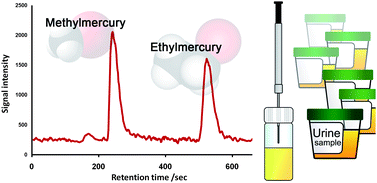Rapid speciation of methylated and ethylated mercury in urine using headspace solid phase microextraction coupled to LC-ICP-MS†
Abstract

* Corresponding authors
a
Department of Chemistry, Hong Kong Baptist University, Kowloon, Hong Kong SAR, PR China
E-mail:
s9362284@hkbu.edu.hk
Fax: (+852) 3411 7348
Tel: (+852) 3411 5297
b Department of Clinical Biochemistry, Queen Mary Hospital, Hong Kong SAR, PR China

 Please wait while we load your content...
Something went wrong. Try again?
Please wait while we load your content...
Something went wrong. Try again?
Y. Tsoi, S. Tam and K. S. Leung, J. Anal. At. Spectrom., 2010, 25, 1758 DOI: 10.1039/C0JA00024H
To request permission to reproduce material from this article, please go to the Copyright Clearance Center request page.
If you are an author contributing to an RSC publication, you do not need to request permission provided correct acknowledgement is given.
If you are the author of this article, you do not need to request permission to reproduce figures and diagrams provided correct acknowledgement is given. If you want to reproduce the whole article in a third-party publication (excluding your thesis/dissertation for which permission is not required) please go to the Copyright Clearance Center request page.
Read more about how to correctly acknowledge RSC content.
 Fetching data from CrossRef.
Fetching data from CrossRef.
This may take some time to load.
Loading related content
